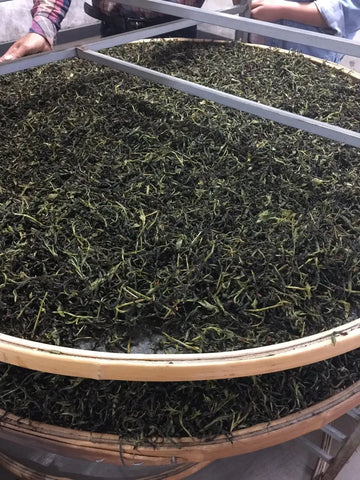
What is Oxidation in Tea?
Last week, we shined some light on the world of tea processing by looking at Long Jing Dragonwell green tea to gain some insight into exactly how some of these teas are carefully hand-crafted and what kinds of steps tea masters take to produce these teas. Another important part of this conversation is something known as oxidation. Oxidation is one of the most important processes that gives us such a wide range of tea and flavor, even from the same varietal in the same region!

All of the tea types that we have are distinguished by how they have been crafted, and most of them involve intentionally manipulating the level of oxidation that the tea leaves undergo. If oxidation is so important, then what is it?
Oxidation is one step of a chemical reaction whereby naturally occurring enzymes within the tea leaves begin to break down other chemicals within the leaves once the tea leaves’ cell walls have been damaged. It is this chemical reaction (or lackthereof) that determines the color of the infusion, the color of the leaves, and the taste of the tea. Oxidation effects everything from polyphenols and chlorophylls to amino acids and lipids, and so even the chemical profile of different kinds of tea will be unique.
The oxidation process begins as soon as the leaves are plucked, but it can be accelerated by damaging the leaves further. Some ways to damage the leaves are by crushing, tearing, tumbling, or rolling them, and this can be done by hand or by machines. As you can imagine, it is much more difficult to accomplish this task by hand, and while it is more labor-intensive, it gives the tea master far greater control over the results, which is one reason why we prefer 100% hand-crafted teas.
Every tea master therefore must decide exactly how much oxidation the tea leaves will undergo in order to produce the right flavors, and so it is imperative that the tea master know when and how to halt the oxidation process. In order to halt the oxidation process, the enzymes responsible for the process must be “denatured,” and much like damaging the leaves, denaturing can occur through traditional methods or conventional ones. Some traditional methods include pan firing, steaming, baking, or sun drying.

The choices that tea masters make regarding how much to oxidize and how are what gives us so many of our wonderful teas. In the case of white tea, for example, the tea leaves are denatured and oxidation is stopped by leaving them out to whither in the sun (or sometimes even in the moonlight!). Our green teas are made by minimizing oxidation as soon as possible in order to help the leaves maintain their bright, vibrant green colors. This is usually accomplished by pan firing the leaves shortly after being plucked. Black teas, by contrast, require additional considerations, such as how much to damage the leaves and which method to use, but in every case, the tea master allows the oxidation process to complete.
Perhaps the most complex tea type when it comes to manipulating the level of oxidation, however, is oolong tea. It is within this class of tea that you can find teas ranging from almost green-like to almost black-like, with plenty of options in the middle as well. Tea masters that craft oolong teas have to pay attention to every single step of the process, determining not just how to damage the tea but also when to stop the oxidation process. These considerations can be the difference between an oolong like a light, floral Tieguanyin or a darker, complex master-roasted Tieguanyin.
Hopefully by learning a little about oxidation as part of the tea crafting process rather than just a chemical reaction, we can raise our next cup of tea to the tea masters that made our cups possible by experimenting with levels of oxidation and how it happens.